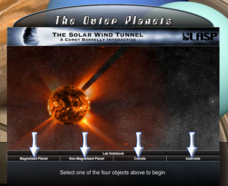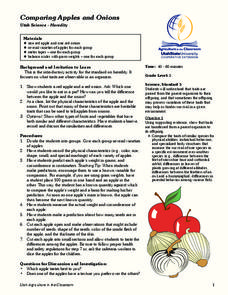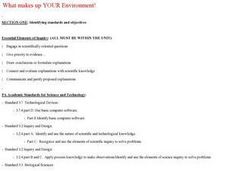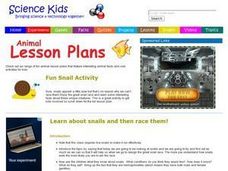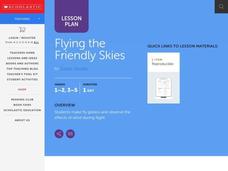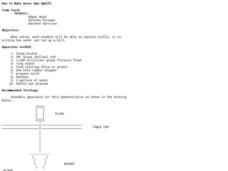Laboratory for Atmospheric and Space Physics
The Solar Wind Tunnel
The winds of change are blowing in our very own solar system! But what makes some heavenly bodies more affected by solar winds than others? Pupils discover the concept of magnetic forces at work in space in this...
CK-12 Foundation
Testing Hypotheses: Einstein
Einstein once said "A person who never made a mistake never tried anything new." Enlist his help in teaching young learners the importance of looking for mistakes in hypotheses. An interactive coaches pupils in the falsifiability of...
Curated OER
Physical Changes and the Water Cycle - Three
Third graders observe and reproduce the water cycle in their very own classroom. A simple, yet very effective, demonstration on how water evaporates is observed by the young scientists. They make observations and sketches in their...
Curated OER
Time-Lapsed Observations
Students explore timed observations for science investigations. They record ideas on a chart related to a classroom closed terrarium. They repeat their observations for several days and time observations for changing shadows during the...
Curated OER
I Wonder Why There Is So Much Frass...
Students examine frass and try to determine what it is. They make observations and add to their growth charts on a daily basis. They make predictions and support them to end the instructional activity.
Curated OER
The Effects of Photosynthesis on Plant Growth
Young scholars examine the process of photosynthesis; its products and reactants, and the sequence of the process. They diagram the light reactions, record observations of plants, and discuss how difficult it is to measure plant growth...
Curated OER
Observation And Listening Skills
First graders read a story about polar bears and make observations as they read. In this observations lesson plan, 1st graders listen carefully and sing a bear chant.
Curated OER
I Wonder Where The Manduca Came From...
Students examine how the Manduca came to America the economic means that made it possible. They discover what frass is and make observations. They make their own speculations on why the Manduca came to America.
Curated OER
Observing Reactions
Learners use the scientific method to complete to experiments that have visible reactions. In this visible reaction lesson, students participate in an experiment with melting ice and one with inflating a balloon. Learners record their...
Curated OER
Observing and Sketching the Lunar Surface
Students explore space science by conducting an illustration activity. In this lunar lesson plan, students discuss what the moon is and the role it plays for our environment on Earth. Students view images of the moon and utilize chalk to...
Curated OER
Twinkle, Twinkle, Little Star
Students identify patterns in the stars. In this constellation lesson, students simulate constellations using black canisters and patterns. Students discuss the points on the constellations and how to draw imaginary lines to see the...
Curated OER
Comparing Apples and Onions
Fifth graders observe and compare apples. In this apples lesson, 5th graders work in groups to record the physical characteristics of a variety of apples. Students predict each apples weight and then weigh them to see if they were...
Curated OER
Sink or Float?
Students make and test predictions about sinking and floating, and classify objects according to whether they sink or float.
Curated OER
What is Science?
Students explore physical science by conducting a plant experiment. In this scientific method lesson plan, students discuss questions scientists ask in order to properly explore certain subjects. Students utilize two plants and place one...
Curated OER
What makes up YOUR Environment!
Students create their own land or water environment. They make their environment livable for all the different animals they collect to put in it. Students research the types of animals that they can have in their environment, and how...
Curated OER
Scientific Thinking
Students participate in four different activities which reinforce an understanding of they way scientists think about the world. They make careful observations of two different pennies, write the procedure for making a peanut butter and...
Curated OER
What's the Weather?
Second graders make daily weather observations, record them with appropriate stickers on a chart, and then summarize them at the end of the week in the form of a bar graph.
Curated OER
Learn about snails and then race them!
Students examine snails and make observations about where their eyes are located, how they eat, and how they move. In this snails lesson plan, students discover information about snails by observing them. Students use magnifying glass, a...
Curated OER
Flying The Friendly Skies
Students investigate the science of flight while creating their own gliders and test them with the lift supplied by wind in the outdoors. They create a chart to make observations of the flight patterns of different gliders taking note of...
Curated OER
The Milk Bottle Quiz
In this scientific statements worksheet, students identify statements as an observation, inference, question, prediction, or factual. This worksheet has 7 matching questions.
Curated OER
The Atom Board-Making Atoms
In this making atoms science worksheet, students read about the atomic number of protons, finding the number of neurons, and how electrons function before they complete the atom board graphic organizer and respond to 4 short answer...
Curated OER
How to Make Water Run Uphill
Students observe science demonstration. In this science lesson, students watch an experiment showing water moving up from an area of higher concentration to an area of lower concentration, due to a change in atmospheric pressure.
Curated OER
Leaf Observations
Second graders examine a variety of leaves. In groups or individually, they write down their observations on each leaf type and compare them to each other. To end the lesson, they share their observations with the class and draw the...
Curated OER
The Water Cycle
Fifth graders explore the major components of the water cycle. They pay close attention to evaporation, condensation, and precipitation. A water cycle kit is set up in the classroom, which learners observe for a couple of days before the...
